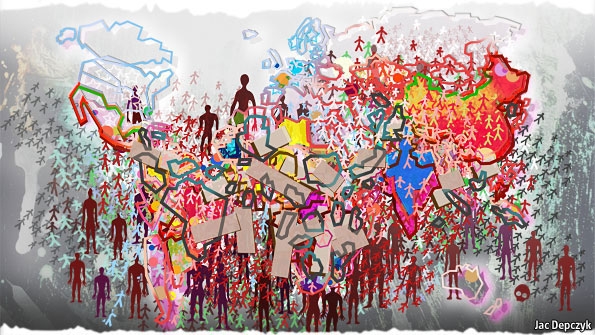Across Asia countries are rapidly transitioning from low to middle income status. This transition is enormously positive, pulling millions of Asians out of poverty, massively increasing levels of education, and creating new opportunities for employment and wealth accumulation. But the ‘miracle’ of Asian growth is deeply unequal, with many in middle-income Asia continuing to experience extreme poverty, and exclusion from the benefits of the thriving regional economy.
The reality is that most of the world’s poor no longer live in low income countries. Most of the world’s extreme and moderate income poor now live in lower-middle income countries [pdf]. In many parts of Asia, economic growth has not alleviated poverty: extreme and moderate poverty have persisted despite higher levels of average per capita income. In Asia, the countries that have achieved lower-middle income status include (in order from lowest to highest income) Vietnam, the Philippines, Indonesia, India, Mongolia and Sri Lanka. Those in the upper-middle income category include China, Thailand, Timor Leste, and Malaysia. Across Asia, the Gini coefficient (the most widely used measure of inequality) has actually increased from 39 per cent to 46 per cent.
Income inequality has even widened in China, India and Indonesia — the very countries that have powered the region’s economic growth. Even in lower-middle income countries where inequality has not increased, it has remained persistently high [pdf] at around 45 per cent for the last 20 years despite overall national economic growth.
This reality has profound implications for where and through which means international development assistance is now delivered.
Middle income countries face the challenge of ensuring stable economic environments, developing human capital, remaining competitive in the global market in the face of rising labour and production costs, improving governance, and tackling growing inequality. Many in the development industry are now focusing on these issues. But many in the development industry are now asking: Is there a role for foreign development assistance in middle income Asia? And if so, in which areas and in which ways can foreign assistance make the most useful contribution?
It is clear that the assistance international development organisations can provide to middle income Asia is dramatically different from the assistance it has historically provided to low income Asia. Middle income Asia has a large and growing skilled and educated domestic workforce capable — as demonstrated in the remarkable developments of the last two decades — of leading and managing the significant economic policy reforms required to support transformational economic growth. For many of Asia’s upper-middle income countries the need for overseas development assistance funds is debatable.
The largest challenge these countries face is not economic growth: Asia has grown and continues to grow rapidly. The largest challenge is the distribution of that growth. This is something in which international development organisations can play a constructive role.
Part of the value-add of foreign assistance is that it is by definition external and not an integral part of domestic political, economic and social power structures. Though aid is inherently political, it does not necessarily operate within the domestic power structure. This outsider role has value.
In the domestic sphere, trusted foreign development organisations have the ability to convene domestic political players and to facilitate dialogue between domestic decision-makers and those who risk falling by the wayside of emerging opportunities. Regionally and internationally, foreign development organisations can also serve in a facilitation and convening role, bringing together regional and international leaders and experts, facilitating the sharing of regional experiences, and supporting regional policy analysis and information sharing. The Australian government has often positioned itself as part of, but separate to, Asia and taken on this convening role, albeit with varying levels of success. Development organisations, including smaller non-governmental organisations with less historically sensitive identities in the region, have also successfully served in this role in discrete instances.
Importantly, international development organisations can keep equity and wealth distribution front and centre in both international and domestic agendas. They can also stand by to provide assistance to Asia’s middle income governments and citizens on creating and implementing policies and programs of inclusive economic growth, if and as needed.
Rosita Armytage is a PhD candidate in Development Studies at ANU, and an independent development consultant.






I am very wary of official development assistance agencies seeking to intervene in the national economic policies of any country whether least developed, low or middle income. This has to be done through a shared research and learning process exploring the policy and practice options open to the countries concerned. There can be strong external input into this process provided it is well informed and from bodies recognised and trusted by the policy and practice makers from the developing country and certainly never with a loud hailer.
But there is a more important point. As countries move up the per capita ranks it would be reasonable, in my view, to expect them to pay for the advice rather than for it to be funded from aid programs. Sometimes free advice is valued at its price. Moreover, a scaled process of charges would also enable a continuation of a dialogues policy and practice research well beyond the stage of aid recipient status. All too often policy and practice exchanges end when aid programs stop.
I’m surprised that no-one has mentioned the raging debate going on between the Ravallion and Duflo camps about the role of inequality, growth and poverty alleviation – or the Asian Development Bank’s changing approach to working in Asia, and its strengths/weakensses. This is a very complicated discussion – it needs deeper examination that has been given here.
Hi Rosita, thanks for you very interesting piece.
Although not in the development field myself (anthropologist by trade), the issue of unequal development is often the topic of conversation in the area of the world I work in – South Korea and Japan. In South Korea, in particular, it is possible to see extremes of both wealth and poverty within a few subway stops of each other. This is perhaps exemplified best with the case of the now globally known Gangnam area, and the nearby, not so well known Sillimdong, an area that has for a long time now somehow missed much of the development enjoyed by other parts of Seoul.
South Korea and Japan are also interesting cases because of the influence of family-owned conglomerates that wield such huge financial and political power in these countries. The likes of Samsung and Toshiba are frequently pointed to as the reason for both the success and hardships of these East Asian economies.
In short, great article, I look forward to reading more from you.
Markus
Hi Rosita,
Interesting post. I was wondering though, what measure for lower-middle and upper-middle income are you using? I was just surprised to see Timor-Leste listed as upper-middle income alongside countries such as Thailand and Malaysia — the World Bank classifies it as lower-middle income and the government there has a goal under its national development plan to move to upper-middle income status. I know the high resources revenue has the potential to skew things in Timor and I think the World Bank accounts for that in its measurements.
Aside from that comment, I agree with you that this change in Asia will also necessitate a shift in how donors, including Australia, engage and view their role in the region. I think Joel Negin’s recent post on the future of aid not being all about the money is really relevant in the case of growing Asia — if donors want to stay in the game they need to make sure they have the competitive knowledge and technical expertise.
Ashlee, you are quite right. Timor Leste should have been listed as a lower-middle income country.
I think it is not only donors that will need to shift the way they engage in the region, but the broader set of development organisations, including NGOs, universities, and development contractors. Joel Negin’s article makes important points, and I particularly agree with his recommendation that donors should be looking to focus on facilitating an open sharing of ideas across the region. But I would also be cautious about framing the future of Australian development assistance as being primarily a technical process of transferring Australian knowledge. Evaluations of development assistance over the past twenty years provide fairly compelling evidence that a focus on technical approaches without actively formulating programs around a deep understanding of the political economy of the region or community, leads to weak outcomes as efforts at reform often encounter serious roadblocks. I would also be wary of recommending that Australia work on justifying the value of Australian knowledge over that provided by other Western donors, or indeed that available within Asia. Middle income Asia has a huge amount of resources at its disposal in terms of highly educated populations and skilled workforces. My experience (in Asia, rather than the Pacific) has been that facilitating knowledge sharing between Asian countries is often more welcome and better received than offers of Western technical assistance.
But as my article stated, I am advocating that as an industry we start looking for other ways to support development in middle income Asia. Serving a convening role between important political and technical actors, and facilitating collaborative relationships between various power holders and interest groups is a good place to start.
Hi Rosita,
Thanks for the article. Without meaning to detract from any of the points you make, I wonder to what extent income inequality is a temporary byproduct of the process of development, that may actually fix itself over time? Your comments about China, India and Indonesia reminded me of an idea in development economics that is embodied by the Kuznets curve. This idea postulates that, as a country develops, the rich get richer earlier than the poor get richer, which results in a rise then fall in inequality over time. I’m not aware of how well this is supported by empirical evidence though. In any case, this is not to say that nothing need be done – high levels of inequality in developed countries is by no means impossible (e.g. USA’s and China’s Gini co-efficients are roughly the same).
Michael
Thanks Michael. I think as you suggest that the empirical evidence does not support the “a rising tide lifts all boats” theory. Economies have clearly grown rapidly over the past forty years, but so too has inequality. Your point on the US is a good one. One has only to spend some time in the States to witness the extremity of the poverty many Americans experience. It is not a model for emulation if we believe that the objective of development is about more than AGGREGATE growth.
Hi Michael,
That’s a good point. And I remember Kuznet’s curves from development economics classes. But, as an empirical question, is there much evidence to suggest that today’s crop of developing countries can expect to ride such curves? I imagine it would have been easy to argue Kuznets was right sometime around 1970, when looking at OECD data, but since then inequality has resumed its rise, suggesting that trajectories of inequality are more complex than might be suggested in initial theorising.
cheers
Terence